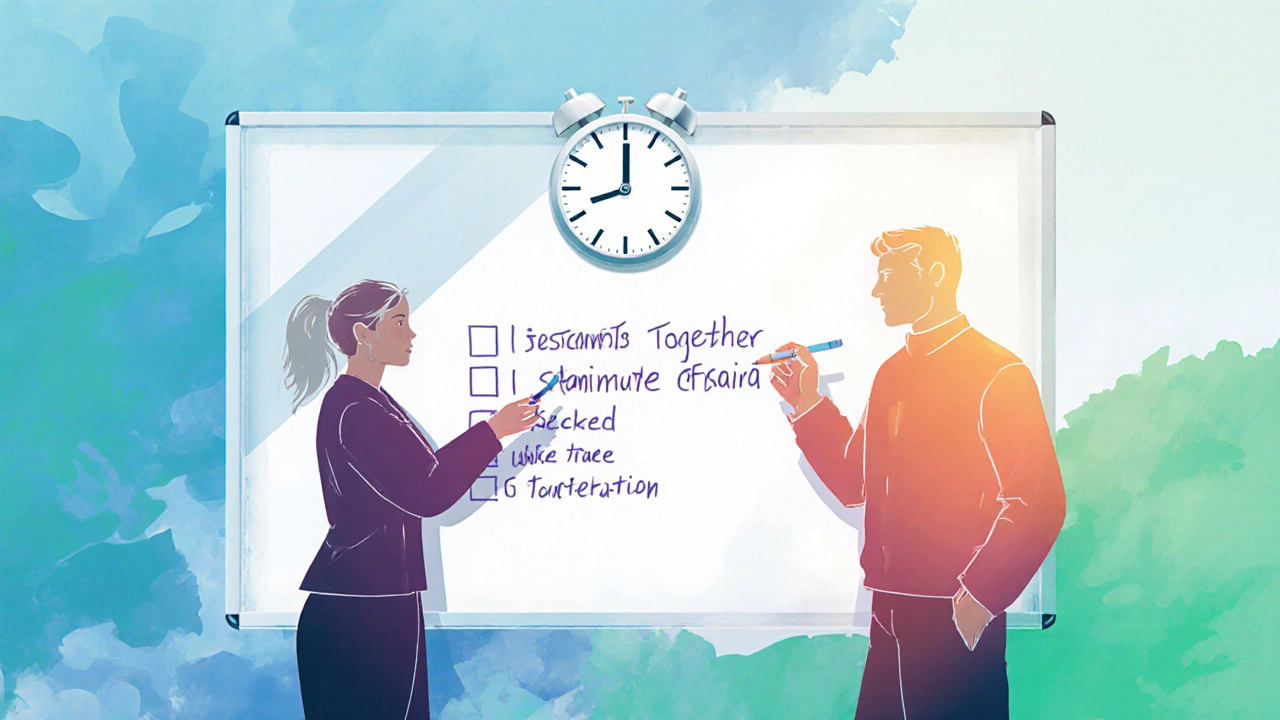2-2-2 Rule Timer
The 2-2-2 rule provides a structured approach to conflict resolution by allocating two minutes each for:
1. Pause, 2. Active Listening, and 3. Collaborative Problem-Solving
Adjust the time per phase to fit your needs, but maintain the three-phase structure for best results.
Phase 1: Pause
Regulate emotions and gather thoughts
Count to 120 seconds. Focus on breath or grounding techniques.
Phase 2: Active Listening
Understand without judgment
Reflect, paraphrase, and ask clarifying questions.
Phase 3: Problem-Solving
Collaborate on solutions
Use "I-statements" and agree on actionable steps.
Why Timing Matters
The article explains that:
- 120 seconds of pause reduces physiological arousal
- Two minutes of listening allows complete expression
- Shorter problem-solving prevents endless debate
When a disagreement flares, many men instinctively reach for a quick fix: a joke, a dismissive comment, or a silent walkaway. Those tactics often leave both partners feeling unheard and the tension unresolved. The 2‑2‑2 rule offers a calm, structured alternative that fits a gentleman’s preference for composure and respect. By allocating two minutes to pause, two minutes to listen, and two minutes to collaborate, you turn a potential clash into a constructive dialogue.
Defining the 2‑2‑2 Rule
2‑2‑2 rule is a simple three‑step communication framework that prescribes two minutes of pause, two minutes of active listening, and two minutes of joint problem‑solving during a conflict. The premise is straightforward: give yourself and your partner a brief, equal‑time window to reset, understand, and resolve. It respects the gentleman’s desire for measured action rather than impulsive reaction.
Why the Numbers Matter
The specific allocation of two minutes for each phase is intentional. Research in conversational dynamics shows that a 120‑second pause reduces physiological arousal, allowing the brain’s prefrontal cortex to regain control. Likewise, a two‑minute listening window is sufficient for most speakers to articulate their core concern without feeling rushed. Finally, two minutes of collaborative brainstorming encourages focused, solution‑oriented thinking rather than a prolonged back‑and‑forth.
Step 1: Two Minutes of Pause
Before you respond, count to 120 seconds. This silent interval serves three purposes:
- Regulate emotions: It lowers cortisol levels, preventing escalation.
- Gather thoughts: You can frame your response with clarity.
- Signal respect: Your partner senses that you value the conversation enough to wait.
During this pause, engage in a brief grounding technique-focus on your breath, feel the texture of the chair, or notice the ambient sounds. Such mindfulness aligns with the gentleman’s cultivated composure.
Step 2: Two Minutes of Active Listening
Active listening is more than hearing words; it’s an intentional effort to understand the speaker’s perspective. Active listening involves reflecting, paraphrasing, and asking clarifying questions without interjecting judgment. Here’s how to apply it within the two‑minute window:
- Maintain eye contact and an open posture.
- After each sentence, briefly summarize: “So you’re feeling… because …”.
- Ask a single clarifying question if something is unclear.
Resist the urge to formulate rebuttals while your partner speaks. This restraint not only honors the conversation but also builds emotional intelligence the ability to recognize, understand, and manage one’s own emotions and those of others, a hallmark of the modern gentleman.

Step 3: Two Minutes of Collaborative Problem‑Solving
With emotions steadied and concerns understood, shift to solution mode. Use I‑statement a communication technique that expresses feelings without blaming, e.g., “I feel… when…” to voice your needs. Then, invite your partner to co‑create an actionable plan.
Example exchange:
“I feel unsettled when we leave plans to the last minute. Can we set a weekly check‑in to confirm our schedule?”
Within the allotted two minutes, aim to agree on at least one concrete step. This focused approach prevents the discussion from drifting into endless debate.
Integrating the Rule into Daily Life
Consistency turns the 2‑2‑2 rule from a crisis tool into a habit. Consider these practices:
- Pre‑emptive check‑ins: Schedule a brief weekly “relationship audit” where you apply the rule to any lingering topics.
- Digital reminders: Set a silent timer on your phone labeled “2‑2‑2” for quick use during spontaneous disagreements.
- Shared language: Agree with your partner to invoke the phrase “let’s do the 2‑2‑2” when tension rises, signaling mutual commitment to respectful dialogue.
Common Pitfalls and How to Avoid Them
Even the most disciplined gentlemen can stumble. Recognize these traps and remedy them promptly:
| Pitfall | Why It Happens | How to Correct |
|---|---|---|
| Rushing the pause | Desire to resolve quickly | Set a visible timer; count silently |
| Turning listening into advice | Habit of fixing problems | Focus on reflection, not solutions, until the third phase |
| Over‑engineering the solution | Fear of future conflict | Agree on a simple, measurable step first |

Measuring Success: Relationship Satisfaction
Effectiveness can be gauged through relationship satisfaction the degree to which partners feel fulfilled, understood, and valued in the partnership. Track these indicators over a few months:
- Frequency of unresolved arguments drops.
- Both partners report higher levels of trust in post‑discussion surveys.
- Emotional climate feels calmer, with fewer raised voices.
If you notice stagnation, revisit the rule’s steps and adjust the timing-some couples thrive with a slightly longer listening window, for example. Flexibility within the framework respects individual attachment styles and communication preferences.
Putting It All Together
The 2‑2‑2 rule blends the timeless virtues of patience, respect, and rational problem‑solving. By allocating two minutes each to pause, listen, and collaborate, you demonstrate a mastery of cognitive empathy the capacity to understand another’s perspective intellectually and a commitment to a healthy partnership a relationship characterized by mutual growth, trust, and balanced power dynamics. Integrate the practice gently, keep the conversation dignified, and observe the gradual rise in mutual respect.
Frequently Asked Questions
Is the 2‑2‑2 rule only for romantic relationships?
While it was popularized for couples, the framework works equally well for friendships, family dynamics, and even professional collaborations where conflict arises.
What if one partner needs more than two minutes to express themselves?
The rule is a guideline, not a strict law. If the conversation warrants a longer listening phase, extend it-but keep the overall exchange focused and avoid endless spirals.
Can the 2‑2‑2 rule be used during high‑stress moments, like financial crises?
Absolutely. In high‑stress scenarios, the pause becomes even more critical for physiological regulation, allowing both parties to discuss solutions without panic.
How does the rule relate to other communication tools like ‘non‑violent communication’?
The 2‑2‑2 rule complements techniques such as non‑violent communication. Both emphasize listening and expressing feelings without blame; the rule adds a timed structure that can be easier to remember in the heat of the moment.
What measurable outcomes indicate the rule is working?
Track reductions in recurring arguments, increased scores on relationship satisfaction surveys, and observable calmness during disagreements. Over a quarter‑year, these metrics typically show steady improvement if the rule is applied consistently.

